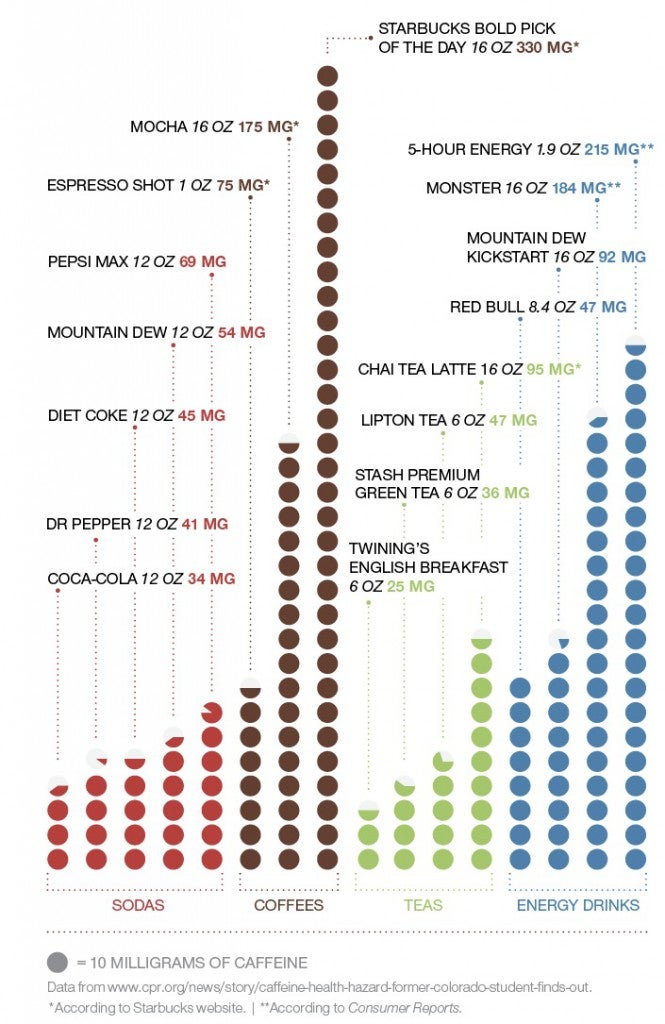
While traveling the world to understand everything there is to know about caffeine, Murray Carpenter uncovers some shocking surprises.

Freelance journalist Murray Carpenter (Psych’85).
The sour stench of ammonia overwhelmed Murray Carpenter (Psych’85) as he arrived at the chemical plant he traveled across the world to see. Resembling a miniature oil refinery in a deteriorating industrial park, the plant’s complicated network of pipes and tanks barely stood out among the numerous neighboring pharmaceutical plants. Three workers taking a smoke break outside nervously shifted their gaze from Carpenter to his translator as they poked their way around the gated and guarded entrance. In Shijiazhuang, China, Westerners weren’t a common sight.
Carpenter, a freelance journalist, was standing at the foot of the largest synthetic caffeine plant in the world. It shipped 4.7 million pounds of caffeine to the U.S. in 2011, and most Americans who have consumed soft drinks since then likely have consumed its caffeine. The plant, along with two other plants in China and one in India, synthesizes more than half of the caffeine Americans consume.
 He was denied entrance to the factory, which only heightened his resolve to find answers to where caffeine comes from and the effects it has, man-made or not, on consumers. His inquiries took him on a global adventure to such places as the hilly tropics of Colombian coffee plantations, sleepy Mexican cacao farms and a gigantic decaffeination plant in Texas. The culmination of his research resulted in his book Caffeinated: How Our Daily Habit Helps, Hurts, and Hooks Us, published this year.
He was denied entrance to the factory, which only heightened his resolve to find answers to where caffeine comes from and the effects it has, man-made or not, on consumers. His inquiries took him on a global adventure to such places as the hilly tropics of Colombian coffee plantations, sleepy Mexican cacao farms and a gigantic decaffeination plant in Texas. The culmination of his research resulted in his book Caffeinated: How Our Daily Habit Helps, Hurts, and Hooks Us, published this year.
Each stop on his three-year journey brought him to a deeper understanding of caffeine, fulfilling a curiosity that began nearly three decades earlier. As a CU-Boulder student, Carpenter frequented such coffee shops as Brillig Works, Trident Café and now-shuttered Penny Lane and was fascinated by how caffeine helped him focus while studying. He wrote a paper on the subject his senior year.
Once he began his research for the book, however, he experienced how interested others were in the substance, too.
“When people found out what I was doing, they would start peppering me with questions,” Carpenter, 52, says. “People really are endlessly fascinated with caffeine. Yet there’s not a lot of consumer information out there because it’s an uncomfortable conversation for Starbucks, Coca-Cola, 5-Hour Energy or any of those companies to have and to discuss the fact that they are in the business of selling a drug that makes you feel good.”
This “uncomfortable” aspect was revealed to Carpenter throughout his research into the synthetic caffeine industry, especially on his brief excursion to the Shijiazhuang caffeine factory. It was in stark contrast to the personal walking and tasting tours given to him by friendly owners of lush coffee bean plantations or tropical cacao groves.
The synthetic caffeine industry’s doors were sealed tight.
“I tried to get permission to visit these plants because I was very interested in seeing the [synthetic] process but I couldn’t get access,” Carpenter says. “I think the industry is not as clean as we expect it, and certainly we know that the FDA is having trouble inspecting some pharmaceutical plants.”
How Much Caffeine Are You Drinking?

Synthetic caffeine factories are not often inspected by the FDA, but if not more concerning, neither are pharmaceutical-producing factories. After a 2007 review of the FDA’s foreign inspections, the U.S. Government Accountability Office determined it would take the FDA 13 years to inspect all foreign drug manufacturing plants. The office also noted in a 2011 report on drug safety that the FDA is far from achieving foreign drug inspection rates comparable to those of U.S. inspections.
Until the FDA creates a system for inspecting overseas plants, Carpenter says it is nearly impossible to know for sure under what conditions caffeine is created. Yet Americans are consuming several million pounds of synthetic caffeine a year, often from bottles or cans that fail to have information on whether the caffeine is natural — coming from coffee, tea or cacao plants — or synthetic.
“It’s a conversation that I think a lot of people aren’t interested in having because once you start talking about natural caffeine, it raises the question, ‘Wait, then where is the rest of this stuff coming from?’ ” Carpenter says, adding that sodas, energy drinks and many of the newer caffeine products on the market use synthetic caffeine because it is much less expensive to use than natural caffeine.
... once you start talking about natural caffeine, it raises the question, 'Wait, then where is the rest of this stuff coming from?'
Synthetic production increased during the World War II era when soft drinks gained popularity and coffee consumption reached its peak. Americans were consuming 46 gallons of coffee per person a year on average.
“Americans drink a lot less coffee now than we did in the 1950s,” Carpenter says. “As coffee consumption has declined, soft drink consumption has skyrocketed. Around 1950, Americans were drinking about 11 gallons of soft drinks annually, and now we’re drinking 51 gallons [per person].”
The first American synthetic caffeine factory was created in 1945 by Monsanto — now known for genetically modified crops. Pharmaceutical giant Pfizer soon followed. Unable to compete with the cheaper-produced caffeine abroad, however, all synthetic caffeine production eventually moved abroad.
“When I started reporting this book, I knew that soft drinks had caffeine in them, but I didn’t know where it came from,” Carpenter says. “When I asked people about it, most assumed that it had come from the decaffeination of coffee. And some of it does. But a lot of caffeine is created from chemical precursors in these pharmaceutical plants.”
Synthetic caffeine is created when uracil is used to produce theophylline, a compound structurally and pharmacologically similar to caffeine and found in small amounts in cocoa beans and tea leaves. It is finished off with a dose of methyl chloride, which occurs naturally in low levels in the environment. Acute short-term exposure to high concentrations of methyl chloride in humans has caused severe neurological effects, according to the Environmental Protection Agency.
Yet in its pure form, the chemical compound of caffeine is the same whether it is man-made or natural and there are no apparent health risks from using one over the other, Carpenter explains.
As coffee consumption has declined, soft drink consumption has skyrocketed. Around 1950, Americans were drinking about 11 gallons of soft drinks annually, and now we're drinking 51 gallons [per person].
Regardless of caffeine’s origins, it plays a major part in most Americans’ lives. Studies show caffeine, nothing more than a bitter white powder, sharpens the mind and improves mood. It blocks the adenosine receptors in the brain that trigger sleepiness, thus providing a perceived energy boost. Some athletes use caffeine to enhance performance.
Just 100 milligrams a day, about the amount of caffeine in a small coffee or three cans of soda, can lead to a physical dependence, Carpenter explains. This means that many people need to consume it to avoid the unpleasant withdrawal symptoms of headaches, muscle pain, weariness, apathy or depression.
Despite this, a nutrition and healthy eating report from the Mayo Clinic says that up to 400 milligrams of caffeine a day appears to be safe for most healthy adults. That’s roughly the amount of caffeine in four cups of brewed coffee, 10 cans of cola or two “energy shot” drinks.
So is caffeine bad for us?
A habitual caffeine dose can grow into a bigger health issue if the level of caffeine intake increases. Carpenter reports in his book that a quarter of a teaspoon causes a racing heart, sweating and anxiety, and a tablespoon — 50 cups of coffee or 200 cups of tea — can kill you. For some, only a small dose may lead to stronger symptoms, such as acute anxiety and panic attacks. Others may not feel its effects at all because of an increased tolerance, which occurs when the body develops more adenosine receptors to stop caffeine’s blocking effects.
“Most of us use the amount that’s good for us,” Carpenter says.
Thanks to the extensiveness of Carpenter’s caffeine research and his March book release, reporters from National Public Radio, the Huffington Post, The Atlantic and TIME have made him their go-to source for caffeine-related stories.
“His book blew me away,” says Mark Overly, president and coffee buyer of Denver’s Kaladi Coffee, who met Carpenter at the 2010 World Coffee Conference in Guatemala. “It was fascinating and horrifying at the same time.”
Photography © stillfx/Veer (coffee beans); Patrick Campbell (book cover); Margot Carpenter (Murray Carpenter); Jole Robison (issue cover)





